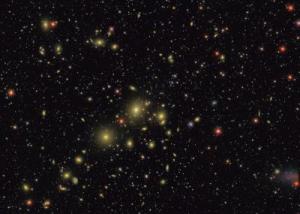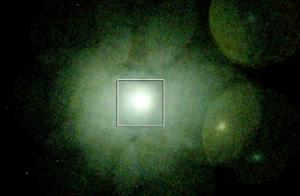|
Related Topics: |
|
|
|
Current News |
|
Chemistry A to Z |
|
About Internetchemistry |
The Largest Known Reservoir of Rare Metals in the Universe |
|
Every cook knows the ingredients for making bread: flour, water, yeast, and time. But what chemical elements are in the recipe of our universe? Most of the ingredients are hydrogen and helium. These cosmic lightweights fill the first two spots on the famous periodic table of the elements. Less abundant but more familiar to us are the heavier elements, meaning everything listed on the periodic table after hydrogen and helium. These building blocks, such as iron and other metals, can be found in many of the objects in our daily lives, from teddy bears to teapots. |
|
Recently astronomers used the Suzaku orbiting X-ray observatory, operated jointly by NASA and the Japanese space agency, to discover the largest known reservoir of rare metals in the universe. Suzaku detected the elements chromium and manganese while observing the central region of the Perseus galaxy cluster. The metallic atoms are part of the hot gas, or "intergalactic medium," that lies between galaxies. "This is the first detection of chromium and manganese from a cluster," says Takayuki Tamura, an astrophysicist at the Japan Aerospace Exploration Agency who led the Perseus study. "Previously, these metals were detected only from stars in the Milky Way or from other galaxies. This is the first detection in intergalactic space." The cluster gas is extremely hot, so it emits X-ray energy. Suzaku's instruments split the X-ray energy into its component wavelengths, or spectrum. The spectrum is a chemical fingerprint of the types and amounts of different elements in the gas. The portion of the cluster within Suzaku's field of view is some 1.4 million light-years across, or roughly one-fifth of the cluster's total width. It contains a staggering amount of metal atoms. The chromium is 30 million times the sun's mass, or 10 trillion times Earth's mass. The manganese reservoir weighs in at about 8 million solar masses. Exploding stars, or supernovas, forge the heavy elements. The supernovas also create vast outflows, called superwinds. These galactic gusts transport heavy elements into the intergalactic void. Harvesting the riches of the Perseus Cluster is not possible. But researchers will mine the Suzaku X-ray data for scientific insights. "By measuring metal abundances, we can understand the chemical history of stars in galaxies, such as the numbers and types of stars that formed and exploded in the past," Tamura says. The Suzaku study data show it took some 3 billion supernovas to produce the measured amounts of chromium and manganese. And over periods up to billions of years, superwinds carried the metals out of the cluster galaxies and deposited them in intergalactic space. A complete history of the universe should include an understanding of how, when, and where the heavy elements formed - the chemical elements essential to life itself. The Suzaku study contributes to a larger ongoing effort to take a chemical census of the cosmos. "It's a part of learning the entire history of chemical element formation in the universe," notes Koji Mukai, who heads the Suzaku Guest Observer program at NASA's Goddard Space Flight Center in Greenbelt, Md. With more than 10,000 galaxy clusters known, astronomers have just barely begun their work. "The current Suzaku result cannot answer these big questions immediately," Tamura says, "but it is one of the first steps to understand the chemical history of the universe." |
|
|
|


